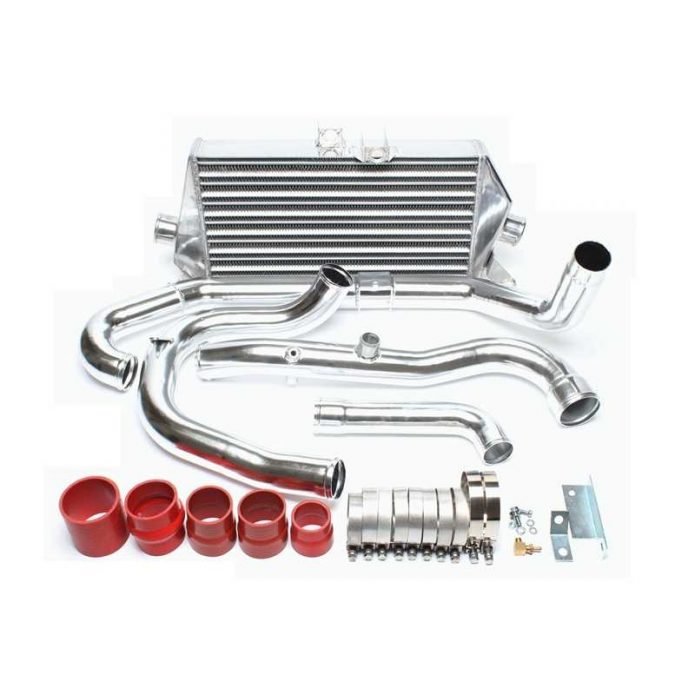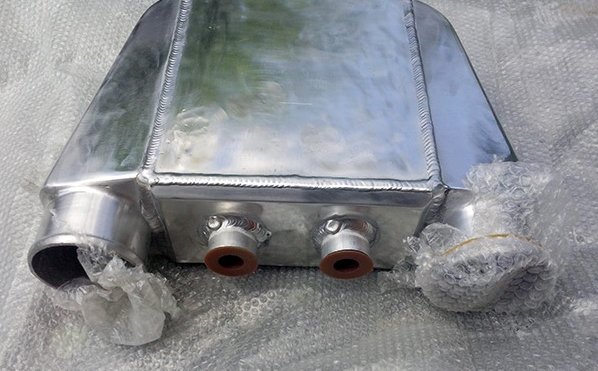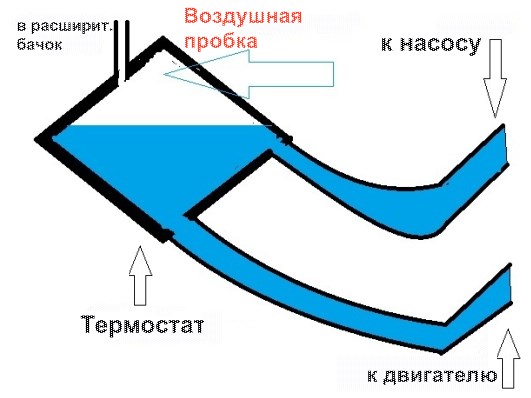
Intercooler in a car: the principle of operation of the device and do-it-yourself repair methods
Content
- What is an intercooler in a car for?
- Diagram of the part and its location in the motor
- The principle of operation of the intercooler and its effect on engine power
- Types of intercoolers
- Is it possible to remove the part
- Selection criteria for self-installation
- Features of operation and the main causes of failure
- DIY intercooler repair
Many cars with powerful turbine engines contain an unusual detail in their design - an intercooler. What is it in a car, how the part is arranged and works, and how to deal with repairs on your own - these are the questions that owners of modern cars are increasingly asking.
An intercooler is a technically unique part of a turbocharged engine, thanks to which the car receives an additional 15-20 horsepower without dangerous consequences. If problems arise, repairs must be made immediately, otherwise the engine turbine will begin to lose power, and over time the power unit will fail.
Content
- 1 What is an intercooler in a car for?
- 2 Diagram of the part and its location in the motor
- 3 The principle of operation of the intercooler and its effect on engine power
- 4 Types of intercoolers
- 4.1 Air
- 4.2 Water
- 5 Is it possible to remove the part
- 6 Selection criteria for self-installation
- 7 Features of operation and the main causes of failure
- 8 DIY intercooler repair
What is an intercooler in a car for?
An intercooler is an intermediate element in the system for supplying air to the cylinders of a gasoline or diesel engine. It is designed for one function - cooling. The task of the device is to lower the air temperature by increasing its density. As a result, the air pressure in the cylinders increases, and the combustible mixture in them becomes more enriched. Equipping an engine with an intercooler increases engine power by an average of 15 percent.
Diagram of the part and its location in the motor
Externally, the intercooler resembles a radiator, consisting of plates and pipes. In order to additionally cool the air, copper or aluminum plates are welded to the tubes.

Externally, the intercooler is not much different from the radiator
In the engine, the part is mounted between the intake manifold and the turbine compressor. It is mounted in front of the engine below the radiator, or above the engine. In some models of cars, the intercooler is located in the wings.
The principle of operation of the intercooler and its effect on engine power
The increase in power is due to the ability of the intercooler to reduce the air temperature to 55-60 degrees. The quality of the air entering the turbocharger improves, which contributes to a better filling of the cylinders and an increase in engine performance.
The technology justifies itself by 100%, since a decrease in air temperature by only 10 degrees gives the motor from 3 to 5 percent of power. The absence of an intercooler or its malfunction leads to excessive, sometimes up to 200 degrees, heating of the air sucked in by the turbine. This, in turn, reduces the power of the motor, and subsequently can lead to its breakdown.
The operation of the intercooler affects fuel consumption. The combustible mixture burns more efficiently, which means that the required amount of gasoline is also reduced. The efficiency of a part is measured by the reduction in engine temperature compared to ambient temperature. Additionally, the intercooler reduces the boost pressure due to the resistance created by this part. For a good intercooler, a pressure drop of 1-2 psi can be considered acceptable.
Types of intercoolers
Depending on the design and principles of operation, intercoolers are divided into two types:
Air
The intercooler of a simple design is a series of tubes interconnected by rows of plates. In fact, the purpose of the part is to pass air through the tubes coming from outside. The plates allow you to increase the heat transfer area, and due to this, the air has time to cool before it enters the turbine.
An air intercooler allows you to reduce the temperature of the air supplied to the turbine by 40-50 degrees, which gives a 12 to 15% increase in engine power. The efficiency of the part can only be assessed at speeds above 30-40 km/h.

In an air intercooler, also known as an air-to-air intercooler, the flow of advancing air acts as a coolant
Air models are installed in three places:
- Under the hood, directly above the engine.
- Behind the front bumper.
- In the lateral spaces of the wings.
The second and third installation options are more appropriate and are more common, since they provide airflow intensity. The air intercooler is most often installed on SUVs and trucks.
The disadvantages of air models are their large mass and impressive size.
Water
Water acts as a coolant in it, which copes with the task much more efficiently. The water intercooler is more compact and does not take up much space under the hood of a car. Although when installing it, you have to find space for the pump and temperature sensor. But the efficiency of this type of part is several times higher.
On average, a water intercooler lowers the temperature by 60-70 degrees. In more advanced and expensive models, a refrigerant liquid acts as a coolant: antifreeze, antifreeze, liquid nitrogen. Due to the properties of such coolants, heat transfer is doubled compared to models running on water.

The liquid absorbs heat much more intensively, because water-air intercoolers are much more efficient than their air counterparts
However, this type of detail has some disadvantages. The water model has a more complex design. The work of the part is regulated by a water pump, a temperature sensor and a control unit. This leads to an increase in the cost of the structure and the complexity of repair in the event of a breakdown. Therefore, models in the lower price range mainly use air intercoolers. In addition, this device requires systematic monitoring of the coolant.
It is interesting! On domestic car models, intercoolers costing about 10 thousand are mainly installed, on imported ones - from 50 thousand rubles. There are more advanced models, the price of which is in the hundreds of thousands of rubles. Sports cars made according to special projects are equipped with a special type of intercoolers - custom ones, in which cooling is carried out using ice and a special liquid.
Is it possible to remove the part
An intercooler is an additional part of the engine, without which the engine may well function. Rejecting it lightens the car by a couple of tens of kilograms and allows you to free up space under the hood. However, experts do not recommend getting away from the intercooler if it is provided for by the design of the car's motor.
Rejection of the coolant will lead to premature engine wear due to exposure to high temperatures. The engine power will immediately decrease. It is strongly not recommended to remove the part from turbocharged car models.
Selection criteria for self-installation
Tuning your own car involves replacing or installing an intercooler yourself. If the owner of the car is on fire with the idea of changing the part to a more advanced model, it is worth considering the following selection criteria:
- heat exchanger area. The size of the tubes and plates directly affects the performance of the part. On sale there are very compact models, the size of a book. However, the feasibility of installing them is rather doubtful, and can hardly provide an optimal increase in engine power. Before buying, you need to calculate the installation location of the part so that it fits exactly into the seat.
- The size of the internal section of the tubes. The design must ensure the free passage of air through it.
- The thickness of the heat exchanger plates. The work is affected by the area of the part, but not by the wall thickness. The pursuit of thick metal will only add weight to the part, but will not affect its efficiency in any way.
- Tube shape. The optimal choice is conical segments with the largest possible bending radius.
- High-quality connection pipes. This is especially important when choosing a water intercooler, since poor-quality connection of parts will lead to coolant leakage.
Features of operation and the main causes of failure
Modern models of intercoolers do not require special care for a long time. However, periodic inspection and timely diagnosis of failure are necessary. The following damage may be found in the part:
- Rupture of a branch pipe or heat exchanger due to excessive pressure. This breakdown is indicated by a sharp drop in car power and increased fuel consumption. There is no point in repairing torn pipes, since under air pressure they will immediately fail again. In this case, only replacing the nozzle will help restore performance.
- Oil entering the interior. Normally, a small amount of oil enters the intercooler while the turbo is running. Permissible indicators - 0.7-1 liter per 10000 km. If the indicators are higher, you should think about repairing the part.
- Cracks in tubes and plates. An intercooler installed in the fenders or under the front bumper is subject to increased mechanical stress.
- Clogged tubes. This is especially intense in winter. therefore, in winter, cleaning the part from chemicals and sand should be carried out as often as possible.
DIY intercooler repair
Repair of a part begins with its dismantling. It is inappropriate to describe specific removal steps, since it all depends on the place and method of installing the part in the car. For example, if the part is installed above the motor, it is simply “pulled off” by loosening the clamps. When the intercooler is installed in one block with radiators (main, automatic transmission, air conditioning), some effort will have to be made.
It is important! The intercooler can only be removed from a completely cool engine with the ignition system turned off.
For a complete repair, it is necessary to dismantle the part
After removing the part, take the following steps:
- Cleaning. In time, this procedure can last about 2-3 hours. It is especially difficult to get rid of oil smudges. But it is necessary to remove all contaminants: the work of the intercooler in the future will depend on the quality of the work performed. For cleaning, remove all parts and disconnect the nozzles. The outer surface and channels are thoroughly washed with special auto chemicals, and for better oil removal they are soaked for several hours. Gasoline and other oil thinners must not be used: they can damage the material from which the part is made.
- Closing cracks. The cracked element is removed from the body of the part, the place of damage is cleaned with a file and a platinum patch is soldered onto it. The material of the insert must match the material of the removed tube.
- Pressurization in a water bath or testing with a smoke generator. Before installing the repaired part in place, it will not be superfluous to check the quality of the repair. This will save the motorist from the need to re-remove in case of poor-quality work. The real test of the part is driving at sufficient speed. If the motor works with its former power, and no extraneous whistle is heard during the "re-gassing", then the performance of the part has been restored.
It is important! The most serious failure is a violation of the ventilation crankcase, which occurs due to the excess oil level in the part. Local repair in this case will not solve the problem. It will take a major overhaul of the motor and replacement of the intercooler.
To cope with minor repairs and maintenance of the intercooler is quite within the power of any car owner. In the event of a serious breakdown or if you need to replace the model with a more advanced one, you should contact the specialists of the car repair shop.
Discussions are closed for this page
